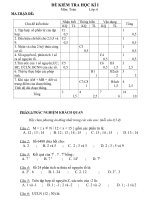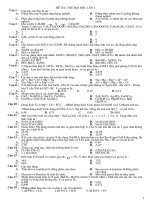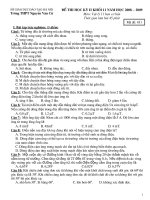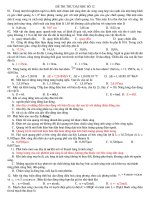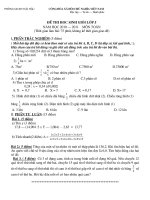Đề thi chuẩn bị kèm đáp án Icho 2020
Bạn đang xem bản rút gọn của tài liệu. Xem và tải ngay bản đầy đủ của tài liệu tại đây (6.56 MB, 221 trang )
PREPARATORY PROBLEMS &
SOLUTIONS
52nd International Chemistry Olympiad
Istanbul, Turkey
Preparatory Problems &
Solutions
CHEMISTRY FOR A BETTER TOMORROW
Fifth edition (04.08.2020)
52nd International Chemistry Olympiad, Istanbul, TURKEY
Preface
We are very glad to provide Preparatory Problems for the 52nd International Chemistry
Olympiad, which will be held in 2020 in Istanbul, Turkey. We prepared these problems with
the intention of facilitating the training and preparation of participants. The contents of the
problems have been carefully selected so as to cover a broad range of challenging topics that
can be encountered in modern as well as classical chemistry. The problems can be solved by
applying the fundamental principles of chemistry covered at high school level along with 6
topics of advanced difficulty for the theoretical section, and 3 topics of advanced difficulty for
the practical section. These advanced topics are listed explicitly under “Topics of Advanced
Difficulty” and their applications are demonstrated in the tasks. We expect the participants to
be familiar with these advanced topics.
The problems listed in this booklet consist of 25 theoretical and 8 practical tasks. The
solutions were sent to the Head Mentor of each country by e-mail by February 10th, 2020 and
published by June 01st, 2020 on our IChO 2020 website. We welcome any comments,
suggestions, corrections, or questions about the problems at
The International Chemistry Olympiad presents a great opportunity to inspire younger
generations to pursue a career in fundamental sciences and make a positive influence on public
attitudes towards science, and in particular chemistry. We hope you will enjoy solving these
problems and we look forward to seeing you in July in Istanbul, Turkey.
Acknowledgments
I would like to express my deep gratitude to all the authors for their dedication and effort in
contributing to the Preparatory Problems as well as the members of the International Steering
Committee for their valuable comments and suggestions. We are also highly appreciative of the
Scientific and Technological Research Council of Turkey (TUBITAK), in collaboration with
the Faculty of Science, Istanbul Technical University (ITU), for facilitating all organizational
tasks before and during IChO 2020.
On behalf of the Scientific Committee,
Dr. Arif DAŞTAN
1
52nd International Chemistry Olympiad, Istanbul, TURKEY
Table of Contents
Authors ....................................................................................................................................... 4
Physical Constants and Equations .............................................................................................. 5
Periodic Table of Elements ........................................................................................................ 7
1
H NMR Chemical Shifts ........................................................................................................... 8
Typical Coupling Constants ....................................................................................................... 8
13
C NMR Chemical Shifts .......................................................................................................... 9
IR Absorption Frequency Table ................................................................................................. 9
Fields of Advanced Difficulty .................................................................................................. 11
Part I: Theoretical Problems ..................................................................................................... 13
Problem 1. Salvia Species Growing in Turkey: Isolation and Total Synthesis of Abietane
Diterpenoids ............................................................................................................................. 14
Problem 2. Istanbulins and Related Sesquiterpene Natural Products ....................................... 22
Problem 3. Çay, Cha, Chai, Te, Tea, Tee, Thé, Thee, and Earl Grey Tea Flavor: Bergamot .. 29
Problem 4. Early Russian Organic Chemists and Markovnikov’s Rule .................................. 32
Problem 5. Arndt–Eistert Homologation .................................................................................. 39
Problem 6. Atovaquone ............................................................................................................ 44
Problem 7. Which is (±)-Trikentrin A? .................................................................................... 50
Problem 8. Stereoisomers of 1,2,3-Triphenylpropane-1,3-diol ................................................ 57
Problem 9. NMR, Symmetry, and Structural Analysis ............................................................ 60
Problem 10. Woodward–Hoffmann Rules and Pericyclic Reactions ....................................... 66
Problem 11. Benzoporphyrin .................................................................................................... 73
Problem 12. Blue to Green, Turquoise ..................................................................................... 79
Problem 13. Spinel Oxides ....................................................................................................... 88
Problem 14. Platinum Complexes as Anticancer Drugs........................................................... 96
Problem 15. Sodium Compounds from Salt ........................................................................... 103
Problem 16. Thermal Springs of Turkey and Sulfur Chemistry ............................................ 110
Problem 17. Electrochemical Determination of Rutin ........................................................... 117
Problem 18. Particle in a Box Problem: Free Electron Model ............................................... 125
Problem 19. Harmonic Oscillator and Rigid Rotor Models ................................................... 130
Problem 20. Journey to Different Earth-Like Planets ............................................................ 135
Problem 21. Rate Constant Models and Kinetic Isotope Effect ............................................. 139
Problem 22. Parallel Reaction Kinetics .................................................................................. 144
Problem 23. Reaction Kinetics with Absorbance Measurement ............................................ 149
2
52nd International Chemistry Olympiad, Istanbul, TURKEY
Problem 24. Acridine Orange / DNA Binding Interactions ................................................... 154
Problem 25. Spectrophotometric Determination of an Antihistaminic Drug ......................... 161
Part II: Practical Problems ...................................................................................................... 166
Problem P1. Drug Delivery from a Polymeric Hydrogel System .......................................... 170
Problem P2. Determination of the Total Carbon Content of Oltu Stone (Black Amber)
Samples................................................................................................................................... 178
Problem P3. Spectrophotometric Determination of the Equilibrium Constant for the Formation
of a Complex .......................................................................................................................... 184
Problem P4. 1-Bromobutane .................................................................................................. 190
Problem P5. Cannizzaro Reaction .......................................................................................... 195
Problem P6. 2,3-Dihydro-5,6-diphenylpyrazine .................................................................... 204
Problem P7. Determination of Rate Constants for n-Butyl Acetate Hydrolysis .................... 209
Problem P8. Activation Energy of Bromide / Bromate Reaction .......................................... 214
3
52nd International Chemistry Olympiad, Istanbul, TURKEY
Authors
ALANYALIOĞLU, Murat, Atatürk University
ARSLAN, Yasin, Burdur Mehmet Akif Ersoy University
AYDOĞAN, Abdullah, İstanbul Technical University
BOZKAYA, Uğur, Hacettepe University
BURAT, Ayfer Kalkan, İstanbul Technical University
DAĞ, Ömer, Bilkent University
DAŞTAN, Arif, Atatürk University (Chair of Scientific Committee)
ELTUĞRAL, Nurettin, Karabük University
GÖLCÜ, Ayşegül, İstanbul Technical University
KANBUR, Yasin, Karabük University
KILIÇ, Hamdullah, Atatürk University
METİN, ệnder, Koỗ University
SARAầOLU, Nurullah, Atatỹrk University
TĩRKMEN, Yunus Emre, Bilkent University
ĩNLĩ, Caner, İstanbul Technical University
YILMAZ, İsmail, İstanbul Technical University
Edited by: SARAÇOĞLU, Nurullah, Atatürk University
4
52nd International Chemistry Olympiad, Istanbul, TURKEY
Physical Constants and Equations
Avogadro's number, 𝑁𝐴 = 6.0221 × 1023 𝑚𝑜𝑙 −1
Boltzmann constant, 𝑘𝐵 = 1.3807 × 10−23 𝐽𝐾 −1
Universal gas constant, 𝑅 = 8.3145 𝐽𝐾 −1 𝑚𝑜𝑙 −1 = 0.08205 𝑎𝑡𝑚 𝐿 𝐾 −1 𝑚𝑜𝑙 −1
Speed of light, 𝑐 = 2.9979 × 108 𝑚𝑠 −1
Planck's constant, ℎ = 6.6261 × 10−34 𝐽 𝑠
Faraday’s constant, 𝐹 = 9.6485 × 104 𝐶 𝑚𝑜𝑙 −1
Mass of electron, 𝑚𝑒 = 9.10938215 × 10−31 𝑘𝑔
Standard pressure, 𝑃 = 1 𝑏𝑎𝑟 = 105 𝑃𝑎
Atmospheric pressure, 𝑃𝑎𝑡𝑚 = 1.01325 × 105 𝑃𝑎 = 760 𝑚𝑚𝐻𝑔 = 760 𝑡𝑜𝑟𝑟
Zero of the Celsius scale, 273.15 𝐾
1 picometer (pm) = 10−12 𝑚; 1Å = 10−10 𝑚; 1 nanometer (nm) = 10−9 𝑚
1 𝑒𝑉 = 1.6 × 10−19 𝐽
1 𝑐𝑎𝑙 = 4.184 𝐽
1 𝑎𝑚𝑢 = 1.66053904 × 10−27 𝑘𝑔
Charge of an electron: 1.6 × 10−19 𝐶
Ideal gas equation: 𝑃𝑉 = 𝑛𝑅𝑇
Enthalpy:
𝐻 = 𝑈 + 𝑃𝑉
Gibbs free energy:
𝐺 = 𝐻 − 𝑇𝑆
𝛥𝐺 = ∆𝐺 0 + 𝑅𝑇𝑙𝑛𝑄
0
∆𝐺 0 = −𝑅𝑇𝑙𝑛𝐾 = −𝑛𝐹𝐸𝑐𝑒𝑙𝑙
Entropy change:
𝑞
∆𝑆 = 𝑟𝑒𝑣
, where qrev is heat for the reversible process
𝑇
𝑉
∆𝑆 = 𝑛𝑅𝑙𝑛 𝑉2 (for isothermal expansion of an ideal gas)
1
Nernst equation:
0
𝑅𝑇
𝐶
𝐸 = 𝐸 + 𝑛𝐹 𝑙𝑛 𝐶 𝑜𝑥
𝑟𝑒𝑑
ℎ𝑐
Energy of a photon:
𝐸=
Integrated rate law
Zeroth order:
First order:
[𝐴] = [𝐴]0 − 𝑘𝑡
𝜆
𝑙𝑛[𝐴] = 𝑙𝑛[𝐴]0 − 𝑘𝑡
Second order:
1
1
=
+ 𝑘𝑡
[𝐴] [𝐴]0
Arrhenius equation: 𝑘 = 𝐴𝑒 −𝐸𝑎/𝑅𝑇
Equation of linear calibration curve: 𝑦 = 𝑚𝑥 + 𝑛
5
52nd International Chemistry Olympiad, Istanbul, TURKEY
Standard deviation:
2
∑𝑁
𝑥=1(𝑥1 − 𝑥̅ )
√
𝑠=
𝑁−1
Lambert–Beer equation: 𝐴 = 𝜀𝑙𝑐
6
52nd International Chemistry Olympiad, Istanbul, TURKEY
Periodic Table of Elements
1
18
1
H
atomic number
2
Symbol
2
1.008
13
14
15
16
17
atomic weight
He
4.003
3
4
5
6
7
8
9
10
Li
Be
B
C
N
O
F
Ne
6.94
9.01
10.81
12.01
14.01
16.00
19.00
20.18
11
12
13
14
15
16
17
18
Al
Si
P
S
Cl
Ar
26.98
28.09
30.97
32.06
35.45
39.95
31
32
33
34
35
36
Br
Kr
83.80
Na Mg
22.99
24.31
19
20
K
3
4
5
6
7
8
9
10
11
12
21
22
23
24
25
26
27
28
29
30
Ti
V
Ca Sc
Cr Mn Fe Co
Ni
Cu Zn Ga Ge As Se
39.10
40.08
44.96
47.87
50.94
52.00
54.94
55.85
58.93
58.69
63.55
65.38
69.72
72.63
74.92
78.97
79.90
37
38
39
40
41
42
43
44
45
46
47
48
49
50
51
52
53
54
Rb
Sr
Y
Zr
I
Xe
85.47
87.62
88.91
91.22
92.91
95.95
-
101.1
102.9
106.4
107.9
112.4
114.8
118.7
121.8
127.6
126.9
131.3
55
56
72
73
74
75
76
77
78
79
80
81
82
83
84
85
86
Hf
Ta
W
Ir
Pt
Tl
Pb
Bi
Po
At
Rn
Cs Ba
57-71
Nb Mo Tc Ru Rh Pd Ag Cd
Re Os
Au Hg
In
Sn Sb Te
132.9
137.3
178.5
180.9
183.8
186.2
190.2
192.2
195.1
197.0
200.6
204.4
207.2
209.0
-
-
-
87
88
104
105
106
107
108
109
110
111
112
113
114
115
116
117
118
Fr
Ra
-
-
89-103
Rf
Db Sg Bh Hs Mt Ds Rg Cn Nh
-
-
57
58
La Ce
-
59
Pr
Fl
-
-
-
-
-
-
-
-
60
61
62
63
64
65
66
67
Nd Pm Sm Eu Gd Tb Dy Ho
Mc Lv
Ts Og
-
-
-
-
68
69
70
71
Er Tm Yb Lu
138.9
140.1
140.9
144.2
-
150.4
152.0
157.3
158.9
162.5
164.9
167.3
168.9
173.0
175.0
89
90
91
92
93
94
95
96
97
98
99
100
101
102
103
Ac Th Pa
-
232.0
231.0
U
238.0
Np Pu Am Cm Bk
-
-
-
-
-
Cf
-
Es Fm Md No
-
-
-
-
Lr
-
Copyright © 2018 International Union of Pure and Applied Chemistry
Reproduced by permission of the International Union of Pure and Applied Chemistry
7
52nd International Chemistry Olympiad, Istanbul, TURKEY
1
H NMR Chemical Shifts
Typical Coupling Constants
8
52nd International Chemistry Olympiad, Istanbul, TURKEY
13
C NMR Chemical Shifts
IR Absorption Frequency Table
Functional
Group
Type of Vibration
Absorption Frequency
Region (cm–1)
Intensity
(stretch, H–bonded)
(stretch, free)
(stretch)
3600–3200
3700–3500
1150–1050
strong, broad
strong, sharp
strong
stretch
bending
3000–2850
1480–1350
strong
variable
stretch
bending
stretch
3100–3010
1000–675
1680–1620
medium
strong
variable
stretch
stretch
stretch
stretch
1400–1000
800–600
600–500
500
strong
strong
strong
strong
stretch
3300
stretch
2260–2100
strong, sharp
variable, not present in
symmetrical
alkynes
N–H
stretch
3500–3300
C–N
stretch
1360–1080
Alcohol
O–H
C–O
Alkane
C–H
Alkene
=C–H
C=C
Alkyl Halide
C–F
C–Cl
C–Br
C–I
Alkyne
C–H
CC
Amine
medium (primary amines have
two bands; secondary have one
band, often very weak)
medium-weak
9
52nd International Chemistry Olympiad, Istanbul, TURKEY
N–H
Aromatic
C–H
C=C
Carbonyl
C=O
Acid
C=O
O–H
C–O
Aldehyde
C=O
C–H
Amide
C=O
N–H
Anhydride
C=O
Ester
C=O
C–O
Ketone
acyclic
cyclic
,unsaturated
aryl ketone
Ether
C–O
Nitrile
CN
Nitro
N–O
bending
1600
medium
stretch
stretch
3100–3000
1600–1400
medium
medium-weak, multiple bands
stretch
1820–1670
strong
stretch
stretch
stretch
1725–1700
3300–2500
1320–1210
strong
strong, very broad
strong
stretch
stretch
1740–1720
2850–2820 & 2750–2720
strong
medium, two peaks
stretch
stretch
bending
1690–1640
3500–3100
1640–1550
strong
unsubstituted have two bands
stretch
1830–1800 &1775–1740
two bands
stretch
stretch
1750–1735
1300–1000
strong
two bands or more
stretch
stretch
stretch
stretch
stretch
stretch
1725–1705
3-membered - 1850
4-membered - 1780
5-membered - 1745
6-membered - 1715
7-membered - 1705
strong
strong
strong
strong
strong
strong
stretch
1685–1665
strong
conjugation moves absorptions to lower wavenumbers
stretch
1700–1680
strong
stretch
1300–1000 (1150–1070)
strong
Stretch
2260–2210
medium
stretch
1560–1515 & 1385–
1345
strong, two bands
10
52nd International Chemistry Olympiad, Istanbul, TURKEY
Fields of Advanced Difficulty
Theoretical
1. Pericyclic reactions (Cycloaddition and electrocyclization reactions).
2. Nucleophilic substitution reactions at sp2 carbon centers.
3. Spectroscopy: Basic 1H and 13C NMR spectroscopy (chemical shifts, signal multiplicity,
intensity and coupling constants); simple IR spectroscopy.
4. Kinetics: Rate constant models and kinetic isotope effect.
5. Basic quantum chemistry: Electronic energy levels, transitions applied to conjugated systems,
vibrational and rotational motions of molecules (formulas provided), and simple theories of
conjugated systems.
6. Inorganic chemistry: Coordination chemistry (crystal structure, crystal field theory, and
isomerism) and molecular orbital energy diagrams of homo/heteronuclear diatomic molecules.
Notes:
i) The following topics WILL NOT appear in the exam set:
Metal-catalyzed cross-coupling reactions and olefin metathesis reactions.
Use of Microsoft Excel or any related computer software.
Use of derivatives and integrals.
Although a few examples in the preparatory problems are related to biomolecules,
students are not expected to cover any biochemistry or carbohydrate chemistry as
advanced topics.
Inorganic reaction mechanisms.
Molecular orbital diagrams of polyatomic molecules.
ii) Unless important, the reaction conditions such as solvent and temperature have not been
shown on the arrows in the reaction schemes.
Practical
1. Use of a spectrophotometer (mono/double-wavelength measurements).
2. Basic techniques in organic synthesis: recrystallization, thin layer chromatography (TLC),
filtration, and drying of precipitates following the described procedures.
3. Distillation and extraction.
11
52nd International Chemistry Olympiad, Istanbul, TURKEY
Notes:
During the practical exam, students WILL NOT be expected to:
Determine melting points.
Use a rotary evaporator.
Handle and work up moisture-sensitive compounds (using syringes and balloons).
Perform column chromatography.
Produce the hydrogel system by polymerization through the experiments.
12
52nd International Chemistry Olympiad, Istanbul, TURKEY
Preparatory problems: THEORETICAL
Part I:
Theoretical
Problems
13
52nd International Chemistry Olympiad, Istanbul, TURKEY
Preparatory problems: THEORETICAL
Problem 1. Salvia Species Growing in Turkey: Isolation and
Total Synthesis of Abietane Diterpenoids
The genus Salvia, named after a Latin word, salvare (“healer”), has a variety of species with
important medicinal activities. They have been used for the treatment of colds, flu, and
menstrual disorders in most regions of the world since ancient times. In Turkish folk medicine,
Salvia L. species have also been used as a carminative, diuretic, hemostatic, spasmolitic, and
stomachic, and in the treatment of mouth and throat irritations due to their antibacterial and
wound healing properties. The genus Salvia includes over 900 species across the world, 58 of
which are endemic in Turkey.
Female Turkish scientists Ulubelen & Topỗu with co-workers have studied Anatolian Salvia
plants growing in Turkey, and isolated and characterized more than 320 natural products, most
of which are terpenoids, while one third are new diterpenoids.
In one of their studies on Salvia multicaulis Vahl., Ulubelen & Topỗu isolated four new aromatic
abietane norditerpenoids (14), which showed strong antituberculous activity. In addition to the
antibacterial and antifungal activities of the isolated diterpenoids, the plant extracts also showed
antioxidant, antiinflammatory, and cholinesterase inhibitory activities. S. multicaulis has
folkloric use in Anatolia, such as an appetizer, for wound healing, against scorpion stings, and
in the treatment of respiratory and urinary infections and diabetes.
14
52nd International Chemistry Olympiad, Istanbul, TURKEY
Preparatory problems: THEORETICAL
Later, a research group in Turkey developed a synthetic route to obtain derivatives of natural
products 1–4. This problem covers the synthesis of related compounds. The following reaction
schemes illustrate the total synthesis of diterpenoids 1 and 5.
1.1. Draw the structure of the products A–M, without any stereochemical detail. Hint: In
second step (𝐀 → 𝐁), combination of lithium bromide and cerium(IV) ammonium nitrate
(CAN) is used as a brominating reagent. Compound C is a benzaldehyde derivative and used in
the synthesis step of compound M.
1.2. During the cyclization of H to I-1, another isomeric compound, I-2, with the formula
C18H20O, is also formed. Draw the structure of I-2.
15
52nd International Chemistry Olympiad, Istanbul, TURKEY
Preparatory problems: THEORETICAL
1.3. The following reaction scheme is related to the synthesis of 6, a desmethyl derivative of the
diterpenoids 1 and 2. Draw the structures of products N–Y, without any stereochemical detail.
Hint: Compounds R, S and T exhibit acidic character. The transformation of compound V to
W includes Robinson annulation and a possible deformylation reaction steps.
16
52nd International Chemistry Olympiad, Istanbul, TURKEY
Preparatory problems: THEORETICAL
1.4. During the transformation of compound V to W (Robinson annulation step), the use of a
precursor of the α,β-unsaturated ketone, such as a β-chloroketone or N,N,N,-trialkyl-3oxobutan-1-aminium halide (as used in the reaction scheme), can be more favorable. Explain.
1.5. Draw possible tautomeric forms of compound V.
1.6. Compound Y can be also obtained via ring-closing (electrocyclization) of the compound
Z. Draw structure of Z.
17
52nd International Chemistry Olympiad, Istanbul, TURKEY
Preparatory problems: THEORETICAL
1.7. For the transformation of X to Y, which of the following reagents can also be used? (Ignore
SN2' type reactions).
☐
☐
☐
☐
☐
i) PBr3/pyridine; ii) n-Bu3SnH/AIBN
i) PBr3/pyridine; ii) Na/t-BuOH
i) MnO2; ii) DDQ
i) TsCl/pyridine; ii) LiAlH4
i) TsCl/pyridine; ii) DBU
18
52nd International Chemistry Olympiad, Istanbul, TURKEY
Preparatory problems: THEORETICAL
Solution:
1.1.
19
52nd International Chemistry Olympiad, Istanbul, TURKEY
Preparatory problems: THEORETICAL
1.2.
1.3.
20
52nd International Chemistry Olympiad, Istanbul, TURKEY
Preparatory problems: THEORETICAL
1.4. The use of a precursor of the α,β-unsaturated ketone, such as a β-chloroketone or N,N,Ntrialkyl-3-oxobutan-1-aminium halide, can reduce the steady-state concentration of enone and
decrease the possible side reactions of precursors such as self-condensation or polymerization
reactions.
1.5.
1.6.
1.7.
☐
☐
☐
☐
☒
i) PBr3/pyridine; ii) n-Bu3SnH/AIBN
i) PBr3/pyridine; ii) Na/t-BuOH
i) MnO2; ii) DDQ
i) TsCl/pyridine; ii) LiAlH4
i) TsCl/pyridine; ii) DBU
21
52nd International Chemistry Olympiad, Istanbul, TURKEY
Preparatory problems: THEORETICAL
Problem 2. Istanbulins and Related Sesquiterpene Natural
Products
Some elements received their names from different places around the world. In this respect, the
record belongs to the Swedish village of Ytterby, after which four elements were named:
ytterbium (Yb), yttrium (Y), erbium (Er), and terbium (Tb). However, elements are not the only
chemical entities that owe their names to such places. Interestingly, a class of natural products,
istanbulins A–E, received their names from the city of Istanbul. The first two members of this
family, istanbulins A and B, were first isolated by Prof. Dr. Ayhan Ulubelen and co-workers
from the plant Smyrnium olusatrum in 1971. The isolation of the remaining members,
istanbulins C–E, was reported by Ulubelen and co-workers between 1979 and 1982.
22
52nd International Chemistry Olympiad, Istanbul, TURKEY
Preparatory problems: THEORETICAL
Istanbulins constitute a subclass of a much larger family of natural products called
sesquiterpenes. Two important sesquiterpene natural products with a similar 6-6-5 fused ring
system are vernolepin (1) and vernomenin (2). Danishefsky and co-workers reported an elegant
total synthesis of these two natural products in 1976 via the utilization of the Diels–Alder (DA)
chemistry of the so-called Danishefsky’s diene.
Please note that all formulae depicting chiral molecules in this question refer to racemic
mixtures.
In this context, Danishefsky’s diene (3) and the Rawal–Kozmin diene (4) are two electron-rich
dienes that found widespread use in organic synthesis, and their structures are shown below.
TMS: trimethylsilyl; TBS: tert-butyldimethylsilyl
2.1. Draw the major resonance structures of dienes 3 and 4. Indicate the carbon atoms with
higher electron density on each diene.
2.2. Compounds 3 and 4 have been extensively used as diene components in Diels–Alder
reactions. Draw the conformations of 3 and 4 required to be able to enter a DA reaction. Predict
which compound is a more reactive diene in a DA reaction with maleic anhydride (5).
23


